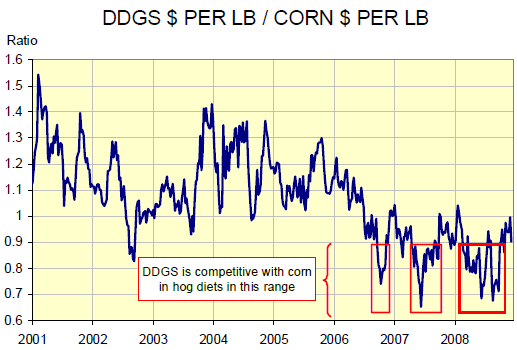



CME: Importance of DDGS in Livestock Diets
US - CME's Daily Livestock Report for 16 December 2008.The price of distillers’ dried grains with solubles (DDGS) is developing a somewhat predictable pattern — at least relative to corn prices. The graph at left shows the weekly ratio of per-pound DDGS and corn prices. The ratio falls during summer months and increases in the fall. We believe these changes are the result of higher DDGS demand in winter months for cows and calves on pasture. That need, of course, declines in the summer months, causing DDGS prices to fall relative to corn.
Note also that the period during which the ratio stays below 0.9:1 is getting longer as DDGS supplies grow. This is important since 0.9:1 represents about the maximum relative price that pork and, to a lesser degree, poultry producers will pay for DDGS. The reason is that DDGS is a comparatively inferior source of energy for pigs and poultry. These relationships all hinge on the relative feeding value of DDGS for the different species so a little animal nutrition background is in order.
Corn is an energy source for animal diets. It has a high carbohydrate fraction and is only about 8.0 to 8.5 per cent crude protein. That protein is relatively low quality, meaning that corn is deficient in one or more of the essential amino acids needed by monogastrics such as pigs, chickens and even humans. These species’ digestive systems cannot make amino acids. They must be present in the diet and the low proportions of lysine, methionine and tryptophan, in particular, in corn protein mean that a corn diet would be deficient in those acids. Pig and chicken diets are supplemented with soybean meal and synthetic amino acids to meet the animals’ specific amino acid requirements.
On the other hand, the microbes in the rumens (ie. multicompartment stomachs) of cattle and sheep can actually manufacture amino acids from low-quality protein and even elemental nitrogen. Therefore, the protein in corn is more useful to them. At only 8 per cent-8.5 per cent, though, there is still not enough of it in a straight corn diet. Cattle diets are supplemented with additional protein in the form of soybean meal, cottonseed mean an other ingredients and/or nitrogen in the form of urea.
Now consider DDGS. It is corn with the starch removed by fermentation thus leaving, in most ethanol plants, all of the fiber, fat, protein and minerals of a 52-lb. bushel of corn in the 17 lbs. of DDGS. That triples the concentration of these other fractions. Hogs and chickens can still use DDGS but at much lower concentrations since DDGS contains much less energy and still doesn’t have enough high-quality protein. Cattle, on the other hand, can efficiently use the low-quality protein and can even convert the higher fiber content into energy —something pigs and birds cannot do. Diets with DDGS reduce the amounts of phosphorous that must be added for all three species — a big issue this past year when prices of phosphorous sources soared.
So, the bottom lines for DDGS are: They are a good energy and protein source for cattle. They are not nearly as good for hogs and chickens. They represent only 17 lbs. per bushel — a bad trade for feed volume. They are being seasonally priced relative to corn and soybean meal.









